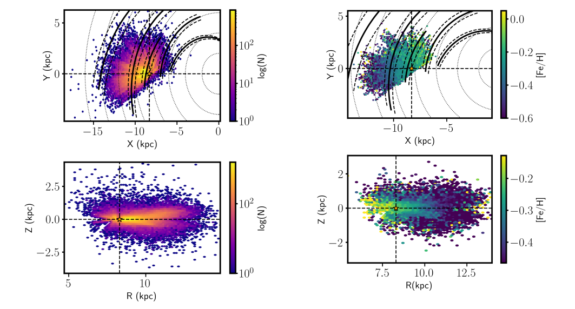On Wednesday, Staff Writer Yacob Melman attended the weekly Astronomy Department colloquium, featuring a talk by Keith Hawkins on finding the origins of stars and galaxies.
At the Astronomy and Astrophysics Department colloquium, on most Wednesdays at 4:05 pm, you can take a step back from the hustle and bustle of New York City and look up to the stars. In the Astronomy Library—located in the highest reaches of Pupin—grad students, postdocs, professors, and the occasional undergrad (myself included) assemble to listen to a guest speaker lecture about research at the cutting edge of the scientific community.
This week featured Dr. Keith Hawkins, a professor at UT Austin, a former Columbia postdoc, and an expert on the chemistry of stars as well as the use of that information to interpret our galaxy’s structure. Or, as he called his field, galactic archaeology.
When he first mentioned the term, I felt a bit stunned, watching every other person nod their heads in understanding. “Galactic” and “archaeology” are not two words that I hear together every day. But, by taking a step back, I saw that my initial assumption was close-minded. By using a combination of physics, chemistry, and mathematics, astronomers can analyze various celestial objects to find out what our galaxy looked like billions of years ago. With enough information, they can construct a timeline of a galaxy’s growth and evolution. History is not at all constrained to the planet we call home.
So what does galactic archaeology ask? The Hawkins group, which focuses on studying the Milky Way, tackles a wide breadth of questions that boil down to one core inquiry: how did our galaxy form? A deceptively simple question, but one whose solution has puzzled astronomers for years. However, Professor Hawkins believes that there exists a method that could eventually solve this mystery.
It is generally accepted that stars form due to the collapse of dust clouds, which leads to the creation of protostars—the hearts of future stars. But these clouds create more than just one star, and there is debate as to whether they form in “clusters” or “strings.” For the creation of galaxies, we still are far from a consensus. Some scientists suggest they form through “monolithic collapse,” where galaxies simply require the collapse of massive gas clouds with enough angular momentum. Other astronomers advocate for the “hierarchical” theory, where smaller units of gas clouds and their corresponding stars merge together. The truth is likely somewhere in between, but there is also one more factor that plays a role: galactic cannibalization. Simulations show that the Milky Way consumed a smaller galaxy in the past, playing a huge role in its current state of existence. We can figure out exactly which galaxy was cannibalized by looking at stars as fossils from the early days of galaxy formation.
As it happens, we are at the perfect time to pursue these answers due to the Gaia space mission. This is the name of an astrometry-focused space observatory run by the European Space Agency that has constructed a catalog mapping the position and motion of billions of stars. This data gave the Hawkins group the ability to see patterns as never before. Using the data, they can use a procedure known as chemical tagging, which uses elemental composition to match stars together based on birthplace. It operates under two assumptions: stars originating from the same cloud of dust will have the same compositions, and stars born in different locations will be unique.
Naturally, the Hawkins group set about confirming this. The first experiment involved binary stars: systems of two stars that have the same birthplace. However, preliminary studies showed that they were chemically dissimilar. This worried the community, but the newly-found data from Gaia came to the rescue. Instead of relying on a few cases, thousands could easily be analyzed. The Hawkins group, one of the first to do so, relievingly found that those first binary stars were an exception, not the rule. After analyzing more of the data, they found that over 90% of binary stars are highly homogenous. This held true even for pairs with extremely wide orbits.

Chemical tagging was a good approximation for pairs, but there are stellar streams consisting of thousands of stars in the Milky Way’s halo. Could they characterize those by birthplace? Looking carefully at the Gaia data, the Hawkins group found strings of stars that shared high abundances of specific elements and similar chemical compositions. After testing more streams, they saw that, although the method did not work for all of them, the approximation was relatively accurate. So, they approached the ultimate hurdle: the galaxy.
Is it even possible to characterize a whole galaxy? Maybe—it’s well known that metal concentration decreases the further away from the center of the galaxy you go, but differences in composition at the same radius have not been found. That is, until now. Recent simulations have shown that patterns should exist at equal radii, and research by the Hawkins group has given results that may help confirm this. Although they are still very early in this process, the mapped-out Gaia data indicates that metallic gradients exist and are potentially concentrated in the spiral arms. Only more time and research will tell if a complete picture can be constructed.

Meanwhile, the Hawkins group will continue their work as Gaia and other missions collect more data. They have several other projects running in tandem, including applying chemical tagging to hypervelocity stars and tagging the galactic center to better improve our knowledge about it. With the power of computing at their side, they may be able to find out where and how the entire Milky Way originated. And let’s be honest—aren’t we all a bit curious too?
Header via Wikimedia
Elemental distribution images via K. Hawkins et al 2022 MNRAS
Binary star composition graph via T. Nelson et al 2021 ApJ


 0 Comments
0 Comments